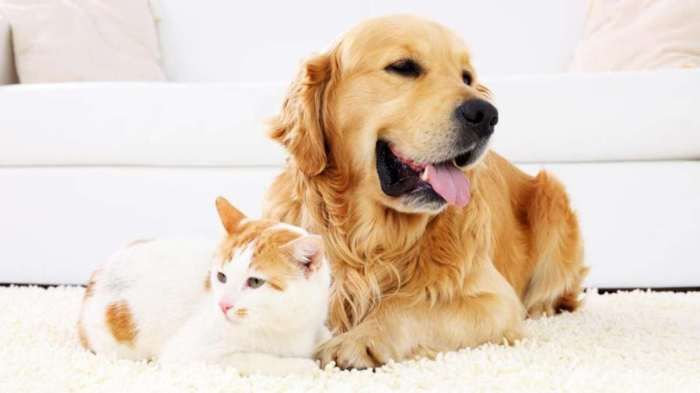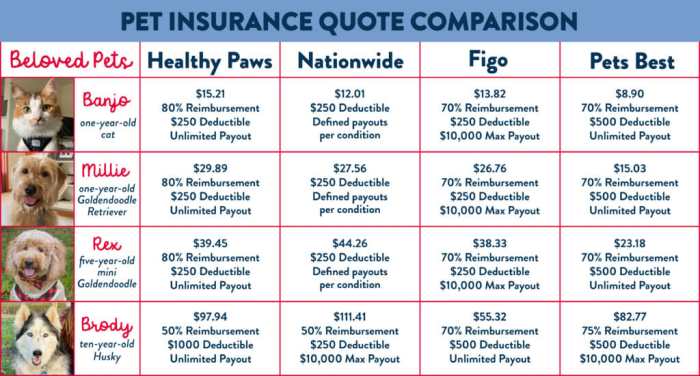When it comes to pet insurance coverage, buckle up as we dive into the world of coverage options, factors affecting costs, making claims, exclusions, cost breakdowns, and specialized coverage for different pets. Get ready for a wild ride!
Types of Pet Insurance Coverage
When it comes to pet insurance, there are different types of coverage available to help you take care of your furry friend. Let’s break down the main categories: accident-only coverage, wellness coverage, and comprehensive coverage.
Accident-Only Coverage
Accident-only coverage is exactly what it sounds like – coverage for accidents only. This type of policy typically includes things like broken bones, poisoning, and other unexpected incidents that require immediate veterinary care. It does not cover illnesses or routine check-ups.
Wellness Coverage
Wellness coverage focuses on preventive care for your pet. This type of policy often includes routine check-ups, vaccinations, flea and tick prevention, and sometimes even grooming services. It helps you stay on top of your pet’s health and catch any issues early on.
Comprehensive Coverage
Comprehensive coverage is the most inclusive type of pet insurance. It usually combines accident and illness coverage, as well as additional benefits like prescription medications, alternative therapies, and sometimes even coverage for lost pets. This type of policy provides the most extensive protection for your pet.
Factors Affecting Coverage

When it comes to pet insurance coverage, there are several key factors that can influence both the cost and extent of the coverage provided. Factors such as pet age, breed, location, and pre-existing conditions play a significant role in determining the coverage options available to pet owners.
Pet Age
The age of your pet can greatly impact the cost of insurance coverage. Generally, younger pets are less likely to have pre-existing conditions and may be eligible for lower premiums. On the other hand, older pets are more prone to health issues, which can result in higher insurance costs.
Pet Breed
Certain breeds of pets are more susceptible to specific health conditions or genetic disorders. Insurers take this into account when determining coverage options and pricing. For example, breeds known for hip dysplasia or heart conditions may have higher premiums due to the increased likelihood of expensive medical treatments.
Location
The location where you live can also affect pet insurance coverage. Urban areas with higher veterinary costs may result in higher premiums compared to rural areas. Additionally, access to specialized care or emergency services can impact the coverage options available in different regions.
Pre-Existing Conditions
Pre-existing conditions can have a significant impact on pet insurance coverage. Most insurers do not cover conditions that existed before the policy was purchased. It’s essential to disclose any pre-existing conditions when applying for coverage to ensure transparency and avoid potential claim denials.
Coverage Exclusions
When it comes to pet insurance, it’s essential to understand what is not covered by your policy. Coverage exclusions refer to conditions or situations that are not included in your pet insurance plan. These exclusions can have a significant impact on a pet owner’s financial responsibility, as they may have to pay out of pocket for certain treatments or services.
Common Exclusions in Pet Insurance Coverage
- Pre-existing conditions: Any health issue or condition that existed before the start of the insurance policy is typically excluded from coverage.
- Cosmetic procedures: Procedures that are considered cosmetic, such as tail docking or ear cropping, are usually not covered.
- Breeding costs: Expenses related to breeding, pregnancy, or giving birth are commonly excluded from coverage.
Reasons for Exclusions
Exclusions exist in pet insurance coverage to manage risk and keep premiums affordable. Insurance companies need to set limits on coverage to ensure the financial sustainability of the policy. Pre-existing conditions are excluded because they are considered a known risk and would result in high and frequent claims, leading to increased premiums for all policyholders.
Impact on Pet Owners, Pet insurance coverage
Exclusions in pet insurance coverage can significantly impact pet owners financially, especially when unexpected medical expenses arise. For example, if a pet owner’s dog develops a hereditary condition that is excluded from coverage, they may have to pay for expensive treatments or surgeries out of pocket. This can put a strain on their finances and make it challenging to provide the necessary care for their pet.
Making Claims
When it comes to making a claim with your pet insurance, the process can vary depending on the provider. However, the general steps typically involve contacting your insurance company, submitting the necessary documentation, and waiting for approval.
Documentation Required
- Medical records from your veterinarian
- Invoices and receipts for treatments
- Completed claim form provided by your insurance company
- Any other relevant documents requested by the insurer
Tips for a Successful Claims Process
- Keep all your pet’s medical records organized and easily accessible
- Submit your claim as soon as possible after receiving treatment
- Double-check that all required documents are included before submitting
- Follow up with your insurer if you haven’t heard back within a reasonable timeframe
Cost of Pet Insurance
When it comes to pet insurance, the cost is a significant factor to consider. Understanding how pet insurance premiums are calculated, ways to potentially reduce the cost, and how coverage limits and deductibles can affect the cost can help you make informed decisions for your furry friend.
Calculating Pet Insurance Premiums
Insurance companies calculate pet insurance premiums based on various factors including the age, breed, and health condition of your pet. The coverage level you choose, as well as your location, can also impact the cost of the premium.
Ways to Reduce the Cost of Pet Insurance
- Consider a higher deductible: Opting for a higher deductible can lower your monthly premium, but keep in mind that you will have to pay more out of pocket in case of a claim.
- Maintain your pet’s health: Keeping your pet healthy through regular veterinary check-ups and vaccinations can help reduce the risk of costly medical conditions, potentially lowering your insurance premium.
- Multi-pet discount: If you have more than one pet, some insurance companies offer discounts for insuring multiple pets under the same policy.
Impact of Coverage Limits and Deductibles
The coverage limits and deductibles you choose can directly impact the cost of your pet insurance. Higher coverage limits and lower deductibles typically result in higher premiums, while lower coverage limits and higher deductibles can lower your monthly cost.
Coverage for Specific Pets: Pet Insurance Coverage

Pets come in all shapes and sizes, each with their own unique needs. When it comes to pet insurance, coverage can vary depending on the type of pet you have. Let’s explore the different coverage options available for specific pets.
Coverage for Dogs
- Dog insurance typically covers accidents, illnesses, and sometimes even routine care like vaccinations and dental cleanings.
- Coverage for dogs may vary based on their breed, age, and size, with some breeds prone to specific health conditions.
- Specialized coverage may be available for breeds with known genetic issues or for working dogs that are more at risk for injuries.
Coverage for Cats
- Cat insurance generally covers accidents, illnesses, and preventive care like vaccinations and flea prevention.
- Coverage for cats may depend on their age, indoor/outdoor status, and any pre-existing conditions they may have.
- Some insurers offer specialized coverage for breeds that are prone to certain health issues, such as Persians or Siamese cats.
Coverage for Exotic Pets
- Exotic pet insurance can vary widely depending on the species, as they may have unique health needs or require specialized care.
- Coverage for exotic pets like birds, reptiles, or small mammals may include medical treatment, emergency care, and even liability coverage if they cause harm to others.
- It’s important to find an insurer that offers specific coverage for your exotic pet to ensure their health and safety.